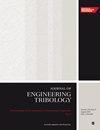Tribological characteristics of ABS structures with different infill densities tested by pin-on-disc
IF 1.8
3区 工程技术
Q3 ENGINEERING, MECHANICAL
Proceedings of the Institution of Mechanical Engineers, Part J: Journal of Engineering Tribology
Pub Date : 2023-02-07
DOI:10.1177/13506501231153521
引用次数: 4
Abstract
Acrylonitrile butadiene styrene (ABS), a petroleum-based thermoplastic, is widely used in various industry. It is important to make product costs without reducing the wear characteristics of products. For this reason, over the past 20 years, researchers have focused on improving product performance by reducing material weight. The literature has limited information about the tribological properties of the ABS polymer samples produced with fused deposition modelling. In this study, gyroid-patterned ABS samples with different infill densities (25%, 50%, and 75%) were produced and the effect on the wear properties of the samples was investigated. The main aim of the study is to show the infill density effect on wear and friction performance of the samples and find the coefficient of friction values. So, this study is one of the first studies which investigated wear and friction properties of ABS polymer produced as gyroid pattern with different infill densities. The study might also be used to have an initial information whether ABS polymer can be used in additive manufacturing systems for the joint components. As the performance indicator, diameter deviation, hardness, surface roughness, test temperature, friction coefficient, weight loss, and wearing surface results of the samples were evaluated. The results show that infill density is an important property that effect the tribological and heating characteristic of ABS samples. The friction and heat of the samples increase by increasing infill density. According to the tribological test results, the highest coefficient of friction and friction temperature were reached in the samples with 75% infill density.不同填充密度ABS结构摩擦学特性试验
丙烯腈-丁二烯-苯乙烯(ABS)是一种石油基热塑性塑料,广泛应用于各个工业领域。重要的是在不降低产品磨损特性的情况下使产品成本降低。因此,在过去的20年里,研究人员一直致力于通过减少材料重量来提高产品性能。关于ABS聚合物样品的摩擦学性能的文献资料有限,这些样品是用熔融沉积模型制造的。在本研究中,制备了不同填充密度(25%、50%和75%)的陀螺仪图案ABS样品,并研究了对样品磨损性能的影响。研究的主要目的是显示填充密度对试样磨损和摩擦性能的影响,并找出摩擦系数值。因此,本研究是国内首次对不同填充密度的ABS复合材料的摩擦磨损性能进行研究。该研究还可用于初步了解ABS聚合物是否可用于关节部件的增材制造系统。以试样的直径偏差、硬度、表面粗糙度、试验温度、摩擦系数、失重和磨损表面结果作为性能指标进行评价。结果表明,填充密度是影响ABS试样摩擦学性能和加热性能的重要因素。随着填充密度的增大,试样的摩擦和热增大。摩擦学试验结果表明,当填充密度为75%时,摩擦系数和摩擦温度最高。
本文章由计算机程序翻译,如有差异,请以英文原文为准。
求助全文
约1分钟内获得全文
求助全文
来源期刊

CiteScore
4.20
自引率
5.00%
发文量
110
审稿时长
6.1 months
期刊介绍:
The Journal of Engineering Tribology publishes high-quality, peer-reviewed papers from academia and industry worldwide on the engineering science associated with tribology and its applications.
"I am proud to say that I have been part of the tribology research community for almost 20 years. That community has always seemed to me to be highly active, progressive, and closely knit. The conferences are well attended and are characterised by a warmth and friendliness that transcends national boundaries. I see Part J as being an important part of that community, giving us an outlet to publish and promote our scholarly activities. I very much look forward to my term of office as editor of your Journal. I hope you will continue to submit papers, help out with reviewing, and most importantly to read and talk about the work you will find there." Professor Rob Dwyer-Joyce, Sheffield University, UK
This journal is a member of the Committee on Publication Ethics (COPE).
 求助内容:
求助内容: 应助结果提醒方式:
应助结果提醒方式:


